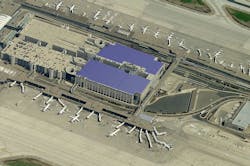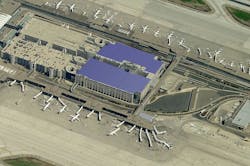FAA awards $10.2 million in low-emission grants to six airports
WASHINGTON, 28 Oct. 2014. Federal Aviation Administration (FAA) officials in Washington awarded $10.2 million in grants, under the FAA’s Voluntary Airport Low Emission (VALE) program, to six U.S. airports with the goal of reducing emissions and improving air quality.
VALE--established in 2005 to help airport sponsors meet air quality responsibilities under the Clean Air Act--is designed to reduce all sources of airport ground emissions in areas of marginal air quality. Through VALE, airport sponsors can use Airport Improvement Program (AIP) funds and passenger facility charges to help acquire low-emission vehicles, refueling and recharging stations, gate electrification, and other airport-related air quality improvements.
“The VALE grants support President Obama’s efforts to combat pollution and improve the air quality for residents in communities near these airports,” explains U.S. Transportation Secretary Anthony Foxx. “The FAA grants will help these airports reduce emissions and that helps the environment.”
The airports to receive VALE grants include:
- Albuquerque International Sunport, $431,479 – to help the airport upgrade the infrastructure to low-emission technology by replacing four boilers in the airport’s central utility plant.
- Hartsfield-Jackson Atlanta International, $102,456 – to enable the airport to purchase two alternative-fuel garbage trucks and convert two passenger vans to cleaner burning fuel instead of diesel.
- Chicago O’Hare International Airport, $2 million – to allow the airport to install an underground fuel-hydrant system, eliminating the need for diesel-powered fuel trucks. The system will provide fuel for 20 gates in Concourse F.
- Dallas-Fort Worth International Airport, $2 million – to help the airport install 12 electric gates at Terminal B and install and connect seven pre-conditioned air units for parked aircraft. The air-unit connection with terminal power will preclude the need for diesel or jet-fuel powered auxiliary power while passengers load and unload.
- Seattle-Tacoma International Airport, $2 million – to allow the airport to install 43 charging units in Terminals A and B to support electric ground support equipment (GSE) such as luggage loaders and aircraft tugs. The electric GSE will reduce the use for conventional fuels and reduce emissions.
- Yeager Airport in West Virginia, $3,678,168 – to fund both gate power units and pre-conditioned air units at seven of the airport’s gates. The units will allow parked aircraft to connect to terminal power while passengers load and unload and preclude the need for diesel or jet-fuel powered auxiliary power.
Through VALE, airports are reducing ozone emissions by approximately 563 tons per year, which is equivalent to removing more than 31,000 cars and trucks off the road annually. In fiscal year 2014, the FAA issued VALE grants for nine projects at nine airports for $11.3 million. Since 2005, the FAA has funded 69 VALE projects at 38 airports, which represents a total investment of $184 million in clean airport technology (including $146 million in federal grants and $38 million in local airport matching funds).
The Airport Improvement Program provides more than $3 billion in annual funding for projects that are vital to maintaining the safety, security, capacity, efficiency and environmental stewardship of the nation’s airports. More than 3,300 airports are eligible for AIP grants benefiting commercial passengers, cargo operations, and general aviation activities throughout the nation.
The VALE program supports the objectives of the President's Climate Action Plan. It builds on efforts to address climate change and support clean energy innovation, including historic investments in advanced vehicle and fuel technologies, public transit, and rail under the Recovery Act, as well as the ambitious new fuel economy standards put into place for cars and trucks, which the Administration has worked to develop since 2009 in collaboration with industry.



